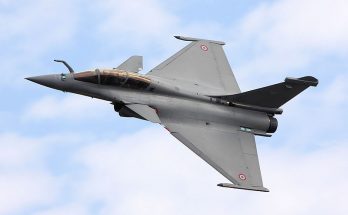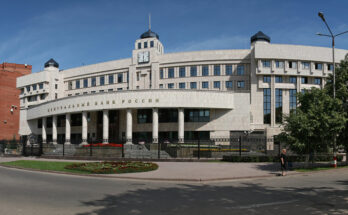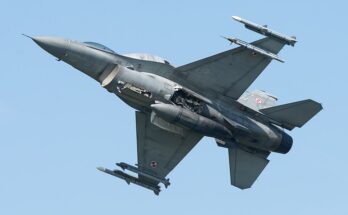
The political climate in Washington, D.C. of late has a way of training the spotlight on a particular country or issue, usually in some connection to U.S. President Donald Trump, before attention is inevitably shifted elsewhere in response to a new breaking news story. It is now Ukraine’s turn in the limelight, stemming from reports that emerged last month regarding a phone call between President Trump and his Ukrainian counterpart, President Volodymyr Zelenskiy, soon after the latter took office. This post will oblige the trend and add further to the commentary on Ukraine, focusing on Kiev’s adaptation to a range of security challenges that have emerged in recent years.
Ukraine’s security outlook took a drastic turn for the worse in 2014. The country was woefully unprepared for the loss of Crimea and the emergence of an armed separatist movement in the east backed by Russia. Navigating the crisis has proved challenging. Under President Petro Poroshenko, who took office in May 2014, Ukraine pursued two key security objectives: deepen relations with Western countries, with an eye towards joining the North Atlantic Treaty Organization (NATO), and modernize the military to prevent any further loss of territory and reestablish deterrence against Russia.
Kiev has prioritized improving ties to the West. At NATO’s Wales Summit in 2014, President Poroshenko noted Ukraine’s “desire to move closer with NATO and become the closet non-NATO ally.” The crisis with Russia served as illustration for why Ukraine would benefit from NATO membership; by the same token, it also underscored why NATO has been cautious about admitting the state. Thus, Kiev has made moving closer to NATO and the European Union a centerpiece of its foreign policy. Ukraine’s constitution has been amended to commit the country to pursue membership in these bodies, and the country is, albeit slowly, reforming its institutions. Kiev makes a point to note to its Western partners that its military is the one guarding Europe’s eastern flank.
While supportive of Ukraine, NATO has been hesitant to directly incorporate Ukraine into the alliance, for concern over signaling to Russia. Besides worry of excessively aggravating Moscow, the alliance would also seek to avoid credibility issues in the event it should be called upon to defend Ukraine and not meet the commitment. Nevertheless, Ukraine’s deeper turn to the West has benefited the country. The U.S. and the E.U. have provided billions of dollars in economic assistance to help Ukraine manage economic reforms and fight corruption.
More pertinent to defense, Western countries have provided military aid to Ukraine and begun selling armaments to the country. NATO members have provided military assistance, and the alliance regularly trains with the Ukrainian forces, a mutually-beneficial experience that offers Ukraine greater compatibility with NATO militaries and gives NATO troops better insight in countering Russian capabilities.
The context for the latest controversial issue gripping Washington is the subject of military assistance to Ukraine, which President Trump temporarily put on hold last month in what critics of the president allege was part of a quid pro quo for Ukraine’s help with a domestic political matter. Since 2014, the U.S. has provided over $1.5 billion in military assistance to Ukraine. Under U.S. President Barack Obama, Washington largely shied away from the supply of “lethal” aid – weapons, in other words – but under President Trump, the U.S. supplied sniper rifles to Ukraine, a small gesture for the military battlefield but a strong signaling move of the U.S.’s growing support for the Ukrainian military. More importantly for Kiev, President Trump’s administration approved the sale of Javelin anti-tank missiles to Ukraine in March 2018. A further sale of the missiles is being negotiated. Kurt Volker, the U.S. Special Representative to Ukraine who recently resigned the role amid the media furor in Washington, urged still greater support for the Ukrainian military, telling The Guardian in September 2018 that the U.S. was interested in discussing both naval capabilities and air defense with Ukraine.
One avenue Ukraine can use to strengthen its ties to the West is through integrating its defense industry into Western supply chains. The country is clearly interested in doing so, though corruption at Ukroboronprom, the main defense conglomerate, is a big barrier. Another is incompatibility between some of Ukraine’s Soviet-origin defense industry capabilities and the systems produced in Western industries.
Even so, Ukraine can offer repair services for some of the systems in service with NATO militaries, especially the eastern NATO members, given the presence of Soviet- or Russian-origin systems in their force structures. Ukraine’s defense cooperation with Turkey pales in comparison to Turkey’s flashy S-400 procurement from Russia, but Kiev and Ankara are pursuing some joint ventures, in the area of electronics, anti-tank systems, and drones. Ukraine’s reported interest in the A-29 Super Tucano probably has more to do with the potential of integrating its industry into the popular light attack aircraft’s supply chain than an interest in deploying it, as it would be vulnerable to advanced anti-aircraft systems in the region. While these efforts are limited, further development in cooperation with Western industries would have the dual benefit of solidifying connections with NATO countries and improving the sustainability of Ukraine’s own industry, which needs a strong export portfolio to remain profitable.
Hand-in-hand with the outreach to the West is the effort to modernize the Ukrainian military. Earlier in the year, NATO Secretary General Jens Stoltenberg said in regards to NATO’s perspective on Ukraine, “We strongly believe that this has to be the main focus: reform and to continue to modernize and to strengthen their defense and security institutions, including fighting corruption.” To join the alliance, Ukraine’s military will need to meet NATO standards.
But even absent the push to join NATO, Ukraine already was keenly aware of the desperate need to overhaul its armed forces, which were in poor shape in 2014. Much of the force structure was in need of overhaul, having been in service for decades without replacement. While the military is still facing difficulties, particularly in introducing truly new-generation systems, its position has improved in some key areas in the nearly six years since the crisis in the east began. Military procurement has been rationalized, focusing on the systems the Army needs to be able to provide security for the country in the immediate time frame. Ukrainian procurement has focused on several areas, among them tanks, artillery, and missile systems.
The T-84 main battle tank, while on paper a strong competitor to Russian models, is too costly to procure en masse and faces a lack of export orders. In practice, it has struggled at international competitions. Tellingly, although Ukraine is said to have under a dozen in service, the tanks are not known to have been used to fight in the east. Instead, Ukraine has modernized its T-64 fleet, settling on a package of upgrades referred to as the “2017 modification,” which have new thermal imagers, improved armor, and better communications and navigation equipment. According to Ukroboronprom, 150 tanks modernized to this standard have been transferred to the military.
Artillery forces have proven to be a key element in Ukraine’s operations against separatists in the east. The country’s defense industry is working on the Bohdana, a self-propelled howitzer that fires NATO-standard 155mm rounds. Ukraine is also in the process of developing more accurate rockets, having conducted extensive testing of the Vilha multiple-launch rocket system. The Ukrainian artillery inventory is large and, given financial and readiness imperatives, will not be replaced overnight – especially given that the country is still procuring second-hand artillery systems from its neighbors – but incremental procurement over time should improve Ukraine’s artillery force.
Missiles are another key direction. As demonstrated in the war in the Ukraine, as well as in Syria and Yemen, anti-tank missiles can wreak havoc on armored vehicles. Ukraine has lobbied the West for supplies of anti-tank systems and has succeeded in securing the delivery of Javelins from the U.S., albeit in small quantities. From its own industry, Ukraine is procuring Corsar and Stugna-P anti-tank missiles. The country is also developing ballistic and cruise missiles. The former, under the Grom-2 project, is likely being developed with external assistance, reportedly from Saudi Arabia. The missile presumably will eventually enter Ukrainian service, particularly if foreign financing can cover research and development costs. On cruise missiles, Ukraine is testing the Neptune, which is slated to enter service in 2020 at the earliest. Testing against maritime targets has been underway since 2018.
Further missile work can be expected, especially on ballistic and cruise missiles. Prior to this year’s elections and amid the collapse of talks between the U.S. and Russia on the Intermediate-Range Nuclear Forces (INF) Treaty, President Poroshenko cryptically said Moscow’s withdrawal from the INF Treaty “lifts restrictions” on Ukraine, which has abided by the INF Treaty’s terms in regards to the development and deployment of certain types of missiles. In April, he more explicitly claimed Ukraine was working on missiles with range exceeding 1,000 kilometers, though none of the recent missile tests have gone to such distances. Ukraine will need to weigh the risk of getting into a missile arms race with Russia that it cannot win . Straying from the admittedly deceased INF Treaty would plausibly kick-start such a race, though it is possible that, with eyes on American weapons, Russia is already planning to deploy its own systems exceeding the INF limits. Ukraine may thus view the Russian deployment of such missiles as inevitable, necessitating Ukraine’s own response, but Ukraine’s plans remain unclear.
To support the modernization goals, Ukraine’s defense budget has expanded rapidly since 2014. The budget for defense specifically has skyrocketed since 2013, exploding to over 100 billion hryvnia (around $4 billion) in 2019 from under 15 billion hryvnia (about $1.6 billion) in 2013. For most of President Poroshenko’s tenure, the defense budget logged double-digit year-on-year growth. It is certainly the case that much of this expenditure growth stemmed from the need to pay troops in the field, but procurement and modernization has seen a boost as well. Spending on the purchase of new weapons and the modernization of existing equipment has increased from only around 4 percent of the defense budget in the period from 2011-2014 to almost a fifth of the budget now, at the tail end of the 2010s.
Comparatively, defense spending in Ukraine remains small, particularly when stacked up against Russia’s expenditures of around 2.9 trillion rubles (over $45 billion). It is moreover not evident that the massive growth of 2014-2018 will be repeated. The upcoming 2020 budget, the first crafted after President Zelenskiy’s election, sees an essentially flat defense budget, at least under the draft plans. These caveats aside, the boost to defense spending has at least made the military’s efforts to reboot its force structures more realistic.
Emphasis on the landward capabilities is not without its drawbacks. One clear casualty is the Navy, which was already smarting from Russia’s annexation of Crimea and seizure of a large number of Ukrainian naval vessels. The Navy is having to make do with a “mosquito fleet,” relegating it to a coastal force. A standoff with Russia last year underscores Ukraine’s lack of maritime deterrence in the present term: In November 2018, Russian forces captured three Ukrainian Navy vessels, including two new patrol boats, as they attempted to cross through the Kerch Strait. The gap will continue to widen. A paper by the deputy head of the Observo French-Russian Analytical Center, Igor Delanoe, sheds light on Russia’s modernization of the Black Sea Fleet, which was largely neglected for the 1990s and 2000s but is now receiving new missile boats, corvettes, and submarines that enable it to counter both Ukraine and NATO in the Black Sea area. While plainly problematic for Ukraine – Russia has demonstrated an ability to establish a blockade of the southeast Ukrainian port Mariupol, should it choose – the military will be hard-pressed to answer for this shortfall. The introduction of the Neptune into service should boost coastal deterrence somewhat, but overall, the Ukrainian Navy will remain outmatched by the Black Sea Fleet.
The Air Force is also receiving less priority. Though nominally interested in building a new combat aircraft, Ukraine is more realistically seeking to prevent deterioration in its present fleet through modernization. The Air Force’s MiG-29s are currently being modernized into the MU1 standard and should, moving forward, be upgraded to a new standard, the MU2, potentially with Israeli assistance. Modernized Su-24s, Su-25s, and Su-27s are also returning to service. That Russia’s Air Force, the only plausible air threat, dwarfs Ukraine’s in terms of size and capabilities and has a strong industry to maintain this gap is a factor in Ukraine’s decision-making on its Air Force. More important than air-to-air is air-to-surface ability, to conduct precision strikes on insurgents in the east. Better accuracy for air-to-surface missiles and munitions is thus one of the elements of the fighter jet modernization effort. The Ukrainian military is also procuring Bayraktar TB2 armed unmanned aerial vehicles from Turkey, deliveries of which began this year, to improve strike capabilities.
A plethora of challenges to Ukraine achieving sufficient deterrence against Russia will persist for the foreseeable future. Much of the force structure will remain outdated or simply modernized versions of outdated equipment. Financing will remain tight and, if corruption is not rooted out, is ever at risk of being squandered. Even so, the country is in a far better position at the start of President Zelenskiy’s term than at the start of President Poroshenko’s, giving President Zelenskiy some breathing room as he addresses his agenda. In his inauguration speech, the new president identified stopping the war in the east as his “very first task.” Towards this end, President Zelenskiy’s government, with criticism from domestic opponents, this week signaled a willingness to work with the separatist east on holding elections, a key requirement towards resolving the multiyear crisis. The track record with political agreements in the war in eastern Ukraine is not quite inspiring, but there remains a possibility that the sides could see success in working towards reconciliation. Doing so would also de-escalate tensions between Ukraine and Russia. The experience of the war and the loss of Crimea will nevertheless continue to influence the development of the Ukrainian military for years to come.
Military markets analyst, covering Eurasia, Middle East, and Africa.




